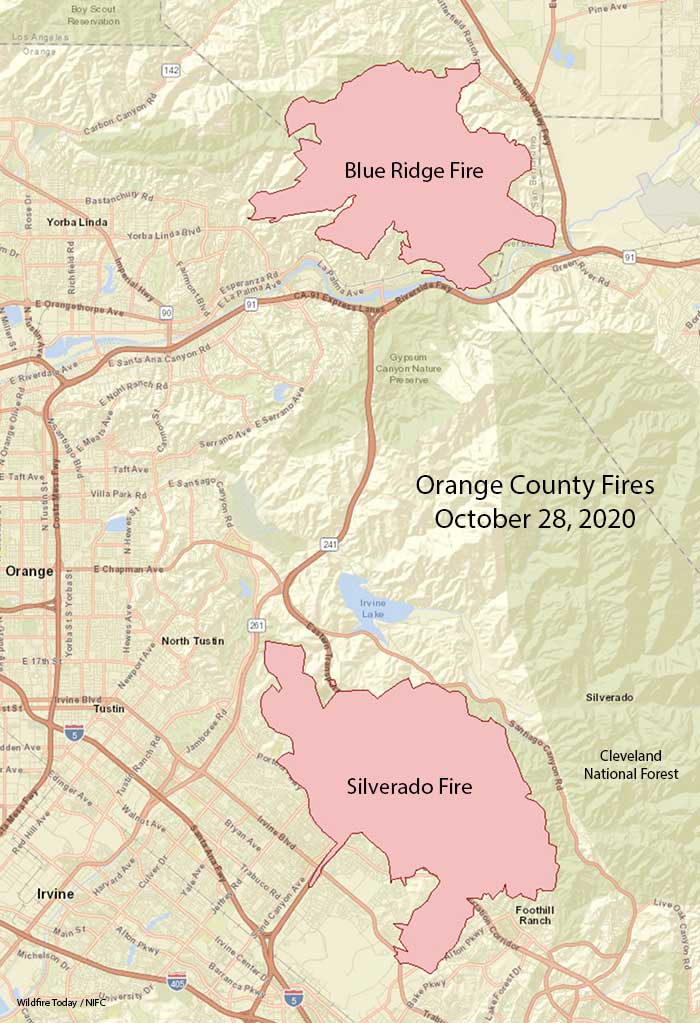Updated October 29, 2020 | 8:16 a.m. PDT
The map shows the perimeters of the Blue Ridge and Silverado Fires, mapped between 8:00 and 8:30 p.m. PDT Oct. 28, 2020. You can zoom in and move around on the map.
Evacuation updates from the Orange County Fire Authority at about 4 p.m. October 28:
Blue Ridge Fire:
•All evacuation orders and warnings related to the Blue Ridge Fire have been lifted effective immediately.
Silverado Fire:
•All evacuation orders are lifted in the City of Irvine
•Some evacuation zones still remain in place for the City of Lake Forest
•Some evacuation zones are lifted for unincorporated areas of Orange County near El Toro Road and Valley Vista
Refer to the Orange County Sheriff’s Department interactive evacuation map for details.
Southern California Edison said it is investigating whether electrical equipment may have caused the Silverado fire. The company reported to the state Public Utilities Commission that a “lashing wire” attached to a third-party telecommunications line may have struck a primary conductor.
October 28, 2020 | 11:16 a.m. PDT

On Tuesday firefighters working on the two large wildfires in Orange County California had their hands full doing their best to contain the Silverado and Blue Ridge Fires.
Strong winds pushed the Blue Ridge Fire west where it approached Gas County Road on the east side of Yorba Linda, and also to the north toward Chino Hills and Soquel Canyon Parkway. As the wind direction shifted during the day firefighters on the east side battled, mostly successfully, to keep it from crossing Highway 71 just north of Highway 91.
The Silverado Fire near Irvine has remained west and south of Santiago Canyon Road. Firefighters conducted a firing operation overnight on the southeast side of the fire.
Tuesday night after 11 p.m. the wind decreased substantially and there was very little significant spread of either fire the rest of the night.
The two fires are being managed under one organization by CAL FIRE Incident Management Team 6 that assumed command at 6 p.m. Tuesday.
The Orange County Sheriff’s Department website has the latest information about evacuations.
Due to the hard work of firefighters from various agencies they’ve been able to ensure the safety of homes from the #BlueRidgeFire. For some, the fire got a little closer than others.
Learn more about creating defensible space around your home here: https://t.co/ccn9ENw8yT pic.twitter.com/n1WmGDoevi
— OCFA PIO (@OCFA_PIO) October 28, 2020
The latest mapping shows the Silverado Fire at 13,354 acres and the Blue Ridge Fire at 14,334 acres.
The map below shows heat detected by an aircraft on the Blue Ridge Fire in Orange, County, California at 10 p.m. PDT Oct. 27, 2020. Most of the vegetation is light, such as grass or brush, and cools a few hours after burning. The fire perimeter is not shown. Yellow is scattered heat, red is isolated heat, and the small brown area is intense heat. You can zoom in and move around on the map.
Status of the two injured firefighters
The two firefighters that were seriously injured Monday on the Silverado Fire, suffering second and third degree burns, are still in critical condition. Their names have not been released. The firefighters were intubated when they were admitted to the hospital, but they are still fighting, Orange County Fire Authority Chief Brian Finnessy said Wednesday morning.
I asked the Chief if there was an address to which we could send cards or letters to the firefighters and their families.
“The families would be so grateful to receive cards or letters,” the Chief said. “They are just now realizing how the fire and aviation family comes together during times like this.”
Here is the address:
OCFA
Attn: Injured OCFA Hand Crew Firefighters
1 Fire Authority Road
Irvine, CA 92602
Let’s flood them with kindness, cards, and letters.

Nearly all of the burned area’s fuel consists of alien weeds that have displaced the native vegetation. These are fast-igniting, fast-burning, flashy fuels that burn like gasoline (packing ratio is near-ideal). As you say, the black cools quickly.
These areas have been severely cow-burnt for years, but nothing has been done to replace the native grasses and shrubs/trees that will suppress the flashy fuels. The perennial, fire-adapted, native grasses and forbs will burn, but not in the same manner as the alien ones that come up cheek-by-jowl every year. The shrubs and trees will burn, but only that fraction that is less than a half-inch in thickness. If deer populations were maintained at their peak, they would graze the grasses down and browse the shrubs and trees up in a way that separates fuels, minimizing vertical progression. The native black walnuts that once grew there in abundance, for example, have relatively little combustible fuels. Time was, pronghorn antelope also grazed and browsed these hills . . .
I’m tired of asking, and society expecting, firefighters to make “heroic” efforts to save homes when all too often the homeowners have done nothing to reduce their risk. It’s time we stopped asking people to become Firewise and start telling them that their inaction to do so and thereby help us will equate to no action by us to protect their fire hazard when the fire happens.
You are right. Life and safety for what can possibly be saved is priority. They do NOT get the fact that fire is not stable. It’s totally different than going to a single house fire with no wind involved.
Some people will never get it. Y’all do a great job and know the majority appreciate that.
Being investigated as powerline fires.